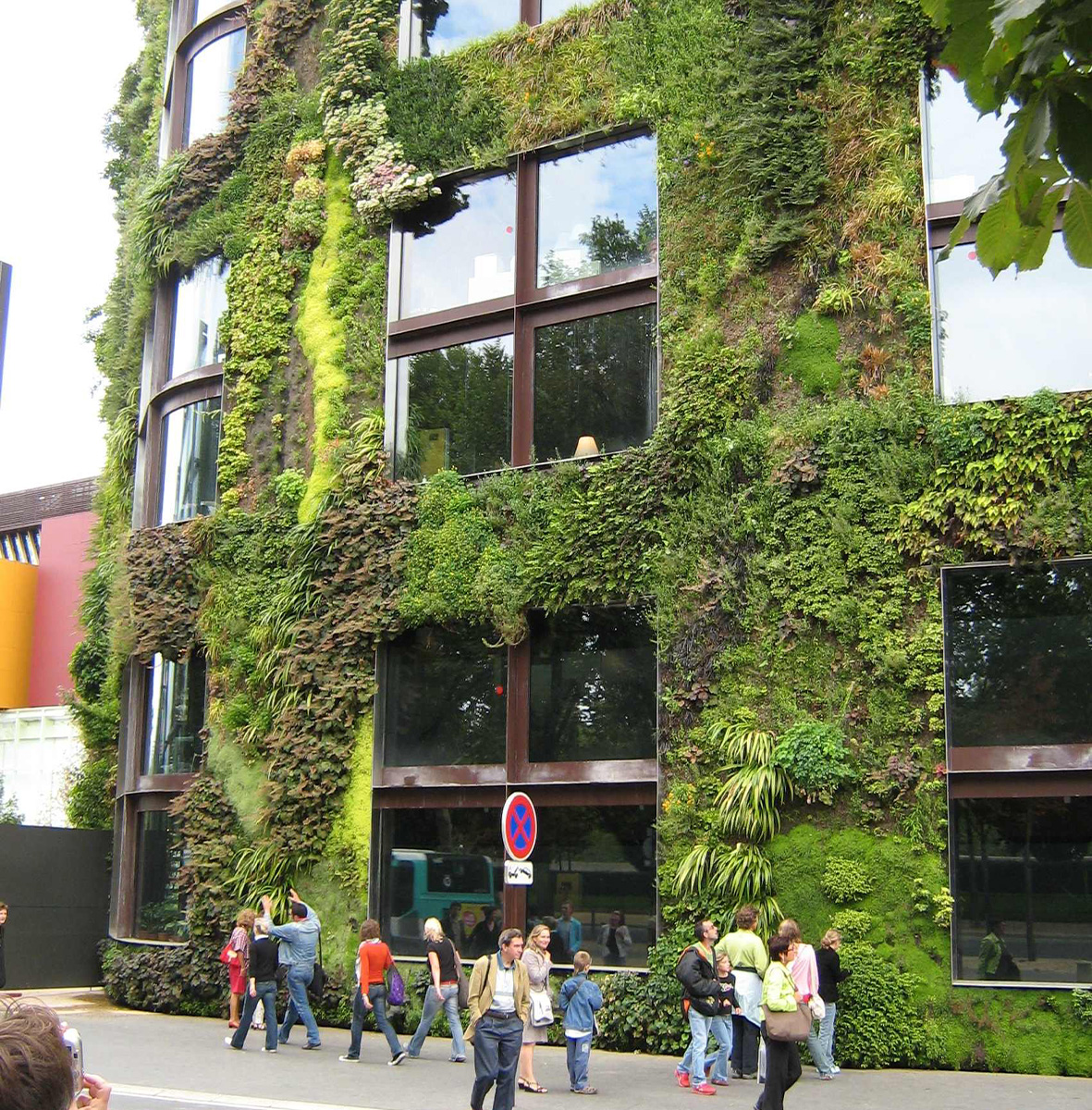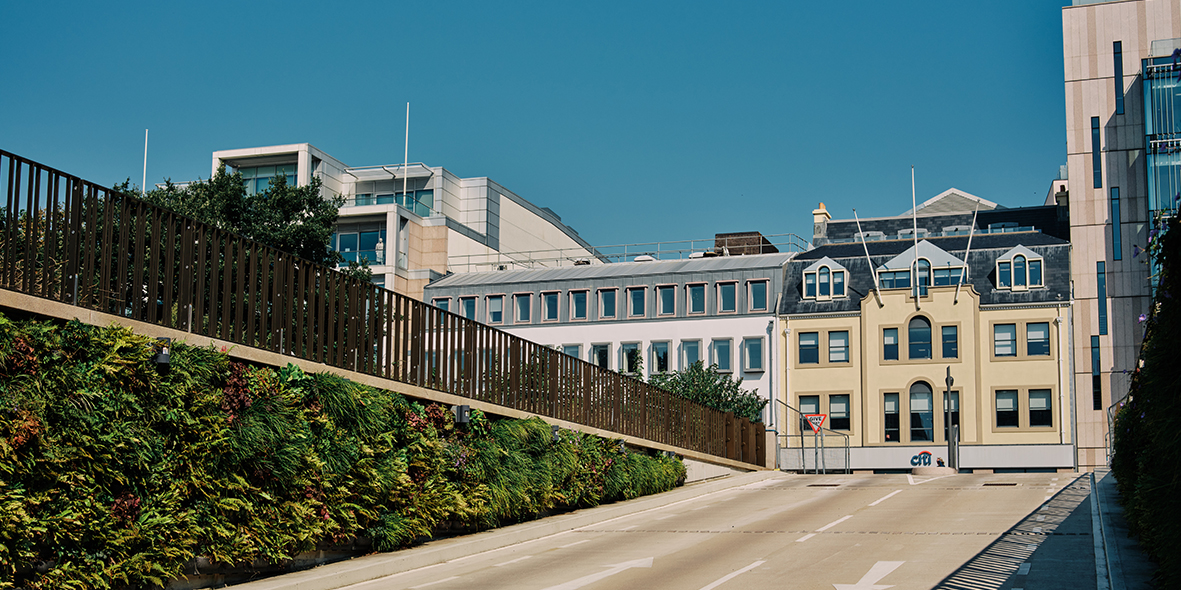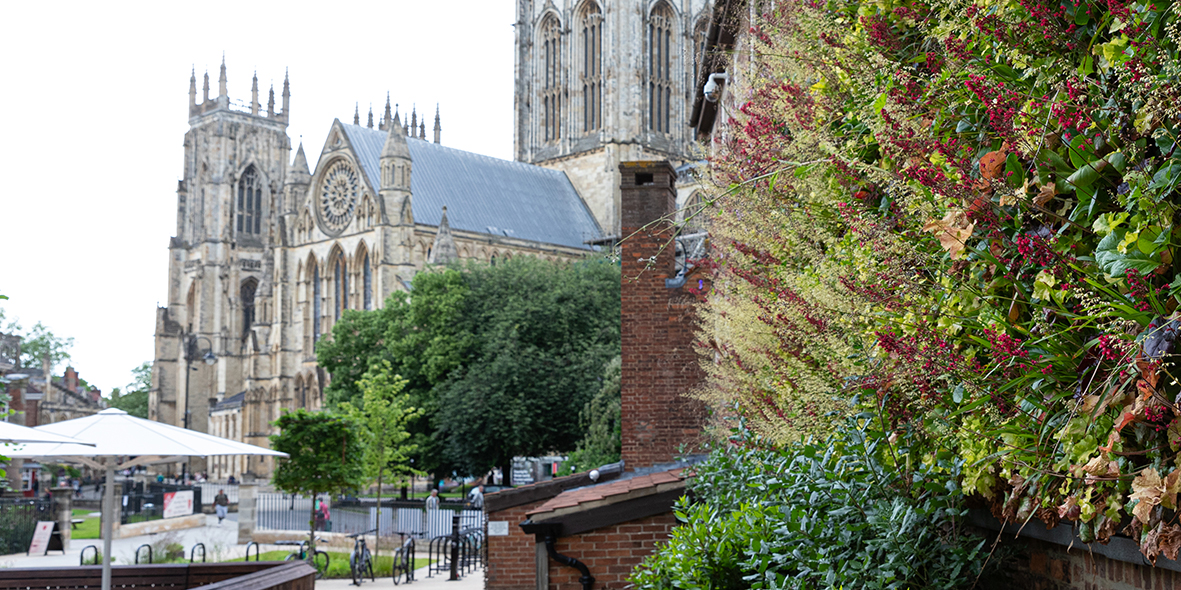Green Talk interview Gary Grant
15 May 2025Who is Gary Grant?
Gary Grant is a Chartered Environmentalist and Fellow of the Institute of Ecology and Environmental Management. Very well known in the environmental, urban greening and landscaping industry in the UK and beyond. Gary has been instrumental in driving forward green roof, living wall and sustainable drainage projects in cities with his direct and knowledgeable approach to integrating greening into the urban environment. We spoke with Gary about living walls and specifically their use within Business Investment Districts.
What led you to an interest in living walls in an urban setting? When did you first discover living walls?
‘Well, in 2006 I went to Paris on holiday with my family, we went to the Musee du quai Branly and I saw the Patrik Blanc living wall there, and I thought, hmm, this is interesting, because you’ve got a large square meterage of greening in a place where normally people would say you can’t do planting here. Of course, most people are just amazed to see all this vegetation all over a huge building, especially with it going around the windows on that one, which adds an extra bit of drama doesn’t it? So that was my first experience of an engineered living wall, I mean, obviously we’ve all seen plants climbing up walls, and there are some spectacular examples which are hundreds of years old. The idea of vertical greening isn’t new, but the idea of quickly and deliberately getting non-climbing plants on a building really was new. Living walls as we understand them now, really became a ‘thing’ 20 years ago. And of course the excitement, as I say, is about the square meterage of greening in an area which doesn’t even show on a plan!’

What are the problems facing the built environment and how can living walls help?
‘The problem is that the built environment is very hot and very dry and barren. It’s an urban desert, really, isn’t it? I know in good towns and cities, we get street trees, if we’re lucky, and that does most of the heavy lifting, if you like, but we need to get more soil, water, and vegetation into towns in order to enjoy all the benefits that plants bring, by cooling in summer, the biodiversity, the shade, and just the sheer pleasure of seeing vegetation. We know the wellbeing benefits of urban greening – it reduces your heart rate and makes you more relaxed, it reduces air pollution and so on. As you know, there’s abundant evidence to back up those claims. You know, back in 2006 there were a few people had written about it and said, well, this is a good thing, but now, since then, the universities have got involved, and they’ve got a pile of evidence to back up all of the claims of the benefits that planting brings to city dwellers.’
Has the pace of living wall adoption in the UK ignited as quickly as you had hoped?
‘It hasn’t taken off as quickly as I thought it would in this country. I mean, we’ve been overtaken already by the Americans. We have been held back by some people in the environmental sector who call it greenwashing, and they’re very negative about it. And some of the points they raise are valid, but it tends to be written off by some as just something that shouldn’t be done, which is a shame, I think. And then we’ve had the Grenfell disaster, which has meant everyone is understandably very sensitive about fire risk. Unfortunately, green walls, although they’re not a major fire hazard, have been swept up in all of that. The government’s been slow to clarify matters, so that’s led to a lot of people making up their own rules, if you like, about that.
Maintenance costs of living walls can be high and because of the extra costs involved, that puts off some property owners. In general, the living wall market is increasing. People now know what they are, builders know what it is, living walls have become part of a universal language of urban architecture and draw attention for their beauty rather than novelty.’

You worked with the Victoria BID on their living wall at the Rubens at the Palace Hotel, how did that come about? What inspired the BID to invest in a living wall?
‘This is a wonderful question and highlights the importance of the role of the green infrastructure audit process, Victoria Business Improvement District was the first green infrastructure audit in London and the audit, which was run by Land Use Consultants with support from the Green Roof Consultancy (now the Green Infrastructure Consultancy), looked at the existing green infrastructure in Victoria, which only had a couple of very small open spaces and some street trees. That’s it. So that was mapped, and then we mapped the potential for introducing more plants, and that was retrofitting green roofs. and the odd rain garden here and there, but there was very little potential for planting at street level. The Rubens at the Palace Hotel had these two massive brick facades, which I think, were created when the road was punched through years ago. The hotel consisted of beautiful Victorian or Edwardian buildings, but with these huge blank walls, these were identified as potential for greening, along with a number of other walls in the area.’
‘The Business Improvement District had commissioned this mapping work, promoted it, and then really, whether or not the projects highlighted in the study went forward was down to the individual owners of each building and businesses. We visited the owners of the various buildings within the BID. We went to the Rubens at the Palace Hotel. It is owned by the Red Carnation Group, which is a privately owned hotel chain. So what’s really interesting about that is, is that you don’t have enormous committees and boards and middlemen to filter out the idea – you literally meet the owner of the building. I met Mrs. Tolman, the owner and put the idea to her, and was delighted and shocked when she said, straightaway, ‘Yes, I’d like to see that happen’. This demonstrates the vision of Mrs Tolman and The Red Carnation Group who really made this living wall possible and understood the benefit to the area and to their brand.’
‘Generally speaking BIDs consist of a partnership of businesses and the local authority. In London at the time when the Rubens at the Palace living wall was installed, there were grants, there was certain amount of money available from the Mayor of London for greening. They had a target for urban greening and very helpful support for sustainable drainage projects as well, which has led to other green walls. So in the London Bridge Business Improvement District, there’s a vertical rain garden, which was funded from a sustainable drainage fund. There was a little bit of financial support, but it’s the owners of the buildings who have to decide and drive the decision to specify greening. The government doesn’t pay for everything, but it’s a partnership. BIDs are there to make things happen. Generally speaking, most of the London boroughs are very supportive. The Mayor of London is very supportive.’
The Rubens wall still looks great and has become a London landmark.
‘Yes, it does, and what this demonstrates the importance of maintenance. The hotel has really embraced that as a feature for their brand and have recognised that maintenance is the key to the ongoing success of the living wall. Like any garden, green walls need to be well maintained. The big misconception that many people have, is that they don’t understand that you do have to maintain these features to a high standard, otherwise they will start to cement unsightly.’

For other BID districts interested in specifying living walls, what in your experience would you consider represents benchmark practice for a living wall installation and irrigation.
‘The first thing is, of course, to go back to basic design ideas, which is the right greening intervention in the right place, there should be some ecological and horticultural thought, because not every location is suitable. Good designers and suppliers should be able to point out that there may be a solution better suited to the chosen place. You know, it might be that climbing plants on a trellis might do the job, and it might be that a tree in that spot would be better in the long run for everyone. So I think we need to look through a hierarchy of possibilities. It’s about hopefully getting something for the long term that’s going to work. And you know, having been through that thought process, that planning and design process, if an intensive green wall is something that would work and would really enhance the neighbourhood and really do something for the building, and if the owner is willing to commit to the maintenance, then, yes, let’s look at the detail of what we can do here, and identify what exactly it is that a BID is trying to achieve? What’s the purpose of it? What about biodiversity? Can we use rainwater harvesting for example. What about the performance, the outcomes that you want, and how to achieve that. A responsible supplier of green walls shouldn’t just sell and not really worry too much about what happens. I think we want to make sure that green wall projects are really going to stick and work.’
Do you believe that Biodiversity Net Gain legislation is encouraging further implementation of green walls?
‘It is helping. But I think there is a tendency to exaggerate the role that biodiversity net gain makes to small urban sites, if you have an urban site with no existing biodiversity, it’s very easy to get 10% net gain. Vertical greening can be a very useful tool with biodiversity net gain, where you’re running out of options and space, and you need to get so many square meters of greening. But it’s not had quite as dramatic an impact on the urban planning development industry as perhaps some people imagine or claim. And you know, you see a advertising which says ‘this is BNG compliant’, and which doesn’t really mean anything. Some people have complained that the scoring for vertical greening isn’t generous enough in the BNG metric. The Urban Greening Factor, which is in London and is now being copied in other cities offers more scope. On the UGF it’s much more important, because the urban greening factor will typically say, we want point four or approximately 40% greening. And if you’ve got a very constrained site, a green wall might be the way forward to meet that target. So I think with UGF, or the equivalent green space factor, (as it’s sometimes called), I think that’s where vertical greening will make a difference. And of course, the green space factor is yet to come. In most cities, it’s being talked about, and that’s where vertical greening will come into its own.’
In summary, when designed with the correct planting and in the right location, living walls bring many benefits to cities, from improved microclimate to air quality improvements, wellbeing, acoustic improvements, and insulation to buildings, keeping them warmer in the winter and cooler in the summer. BID districts are embracing living wall installations in the right locations, where there can be a proven improvement to the area and the participating businesses embrace and drive the idea forward.
With thanks to Gary Grant for his insights.



